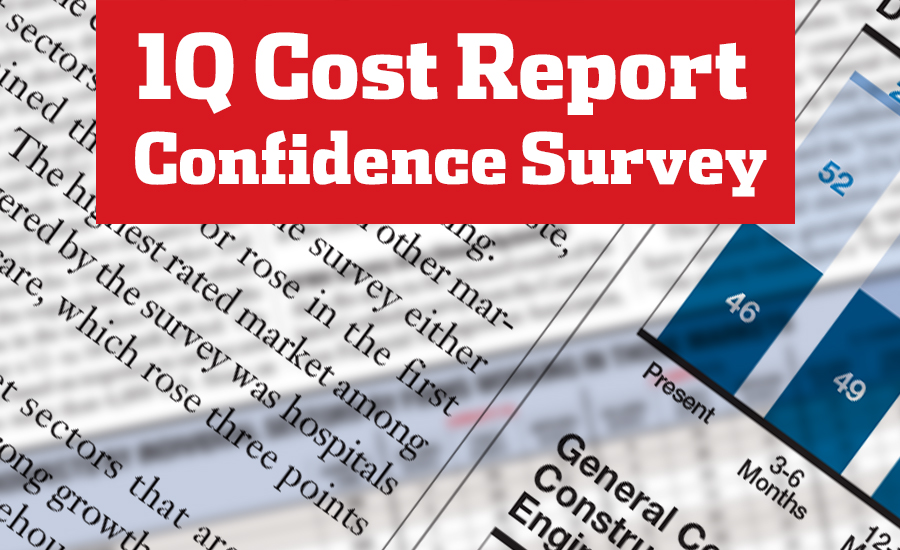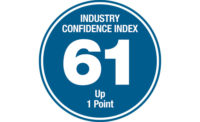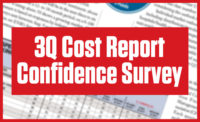It has taken a full year, but with millions vaccinated and millions more in line, some optimism is starting to return to the pandemic-weary construction industry. A surge of hope, mixed with some hesitation, can be seen in the results of ENR’s latest Construction Industry Confidence Index survey.
The index, which had been creeping up slowly since a low rating of 36 in the second quarter of 2020, vaulted 11 points to a 51 rating for the first quarter of 2021, from a 40 rating in last year’s fourth quarter. It is the first double-digit rise in the index since the fourth quarter of 2016. The last three double-digit jumps coincided with the end of a presidential election cycle.
The index measures executive sentiment about the current market, where it will be in the next three to six months and over a 12- to 18-month period. A rating above 50 shows a growing market. The measure is based on 207 responses to surveys sent between Feb. 1 and Mar. 8 to executives of U.S. companies on ENR’s lists of leading general contractors, subcontractors and design firms.
Many industry execs feel that the trend will continue upward. While only 15% of respondents consider the current market to be improving, that jumps to 48% when considering what the market will be in mid-2022. Only 16% foresee a declining market 18 months from now. Optimism is strongest among executives who identify their primary region either as the Midwest or Southeast. The Midwest Index rating jumped 14 points to 57, while the Southeast rating jumped 12 points to 55.
Those numbers are mirrored by the results of the latest Confindex survey from the Princeton, N.J.-based Construction Financial Management Association. Each quarter, CFMA polls 200 CFOs from general and civil contractors and subcontractors about markets and business conditions. The Confindex is based on four separate financial and market components, each rated on a scale of 1 to 200. A rating of 100 indicates a stable market; higher ratings indicate market growth.
The Confindex rose to a 105 rating from 93 in the final quarter of 2020. The “financial conditions” component gained three points to 106, and the “current conditions” component rose 15 points to a 98 rating—both indicative of a belief in a recovering construction economy. The year ahead outlook also rose to 114 from 105 in the last quarter of 2020, a 4.6% increase from the same period the previous year. Most strikingly, the “business conditions” component rose 24 points to 104, an increase of 30%. “[It] is probably the largest single increase we’ve ever had between quarters in any of the industries,” says Stuart Binstock, CFMA’s CEO.
That contradicts some other leading indicators, says Anirban Basu, CEO of economic consultant Sage Policy Group, Baltimore, and a CFMA adviser. “The Architecture Buildings Index continues to suggest that architects are not very busy at all,” he says. Basu attributes optimism among chief financial officers to the restart of many projects that were previously put on hold.
“The economy has outperformed expectations. Unemployment [is] down to 6.2%, GDP [was] growing rapidly during the latter half of 2020 and financial markets surged, even as interest rates remain low,” he says. That has lead to projects restarting that were thought permanently lost to the pandemic.
Basu also believes that public construction may grow significantly in the coming year: “Public construction was strong prior to the crisis [and] many state governments did not suffer as much fiscally as had been predicted early in the crisis.” He cites the state of Maryland, which relies on income tax and retail sales tax for revenue. “White collar workers kept their jobs, so they continued to pay income tax. Retail sales tax collections were pretty decent,” says Basu.
Those states that rely heavily on tourism, such as Florida, fared worse. With $350 billion allocated for state and local aid in the American Rescue Plan, and an infrastructure bill potentially on the horizon, the outlook for public construction is “pretty fantastic,” he concludes.
|
Related Link |
A Cautious Optimism
Industry execs are aware of the challenges that still face them. The majority report seeing lower profit margins than the same time last year, and 82% are seeing material cost increases. Company leaders are also seeing increased competition, with 47% of index respondents reporting higher competition than the same time last year.
In addition, pessimism still dominates some submarkets. Confidence ratings in the commercial office sector (23 rating), entertainment and theme parks (22), hospitality (24) and retail (19) remain at less than half of their pre-pandemic levels.
Although a majority of respondents see a rebound for hospitality and entertainment within 12 to 18 months, 44% see the retail market continuing to decline in the same time period, with only 20% thinking there will be an improvement.
The picture in the commercial office market is only slightly rosier, with 40% seeing a decline over the next 18 months, and just 22% believing it will improve. Basu says that there may be a fair amount of remodeling work available in those sectors, however.






Post a comment to this article
Report Abusive Comment